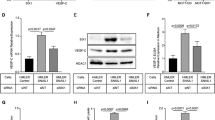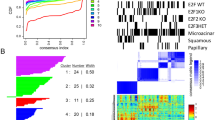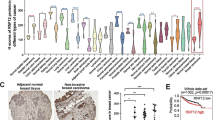Abstract
Six1 is a critical regulator of embryonic development that requires interaction with the Eya family of proteins (Eya1-4) to activate the transcription of genes involved in neurogenesis, myogenesis and nephrogenesis. Although expression of Six1 and Eya family members is predominantly observed in development, their overexpression is observed in numerous cancers. Importantly, both Six1 and Eya have independently been shown to mediate breast cancer metastasis, but whether they functionally interact during tumor progression has not been explored. Herein, we demonstrate that knockdown of Eya2 in MCF7 mammary carcinoma cells reverses the ability of Six1 to induce transforming growth factor-β signaling, as well as to induce characteristics associated with epithelial–mesenchymal transition and cancer stem cells, suggesting that Six1 is dependent on Eya2 to mediate numerous pro-metastatic characteristics. The importance of the Six1–Eya interaction in human breast cancer is underscored by the finding that high levels of Six1 correlate with shortened time to relapse and metastasis as well as decreased survival only when co-expressed with high levels of Eya2. Overall, these data implicate Eya2 as a necessary co-factor for many of the metastasis promoting functions of Six1, suggesting that targeting the Six1–Eya interaction may inhibit breast cancer progression. As Six1 and Eya2 are not highly expressed in most adult tissues, the Six1–Eya interaction may be a valuable future therapeutic target whose inhibition would be expected to impair breast cancer progression while conferring limited side effects.
This is a preview of subscription content, access via your institution
Access options
Subscribe to this journal
Receive 50 print issues and online access
$259.00 per year
only $5.18 per issue
Buy this article
- Purchase on Springer Link
- Instant access to full article PDF
Prices may be subject to local taxes which are calculated during checkout







Similar content being viewed by others
References
Abate-Shen C . (2002). Deregulated homeobox gene expression in cancer: cause or consequence? Nat Rev Cancer 2: 777–785.
Abdelhak S, Kalatzis V, Heilig R, Compain S, Samson D, Vincent C et al. (1997a). Clustering of mutations responsible for branchio-oto-renal (BOR) syndrome in the eyes absent homologous region (eyaHR) of EYA1. Hum Mol Genet 6: 2247–2255.
Abdelhak S, Kalatzis V, Heilig R, Compain S, Samson D, Vincent C et al. (1997b). A human homologue of the Drosophila eyes absent gene underlies branchio- oto-renal (BOR) syndrome and identifies a novel gene family. Nat Genet 15: 157–164.
Al-Hajj M, Wicha MS, Benito-Hernandez A, Morrison SJ, Clarke MF . (2003). Prospective identification of tumorigenic breast cancer cells. Proc Natl Acad Sci USA 100: 3983–3988.
Ando Z, Sato S, Ikeda K, Kawakami K . (2005). Slc12a2 is a direct target of two closely related homeobox proteins, Six1 and Six4. FEBS J 272: 3026–3041.
Behbakht K, Qamar L, Aldridge CS, Coletta RD, Davidson SA, Thorburn A et al. (2007). Six1 overexpression in ovarian carcinoma causes resistance to TRAIL-mediated apoptosis and is associated with poor survival. Cancer Res 67: 3036–3042.
Cillo C, Faiella A, Cantile M, Boncinelli E . (1999). Homeobox genes and cancer. Exp Cell Res 248: 1–9.
Coletta RD, Christensen K, Reichenberger KJ, Lamb J, Micomonaco D, Huang L et al. (2004). The Six1 homeoprotein stimulates tumorigenesis by reactivation of cyclin A1. Proc Natl Acad Sci USA 101: 6478–6483.
Cook PJ, Ju BG, Telese F, Wang X, Glass CK, Rosenfeld MG . (2009). Tyrosine dephosphorylation of H2AX modulates apoptosis and survival decisions. Nature 458: 591–596.
Embry AC, Glick JL, Linder ME, Casey PJ . (2004). Reciprocal signaling between the transcriptional co-factor Eya2 and specific members of the Galphai family. Mol Pharmacol 66: 1325–1331.
Fan X, Brass LF, Poncz M, Spitz F, Maire P, Manning DR . (2000). The alpha subunits of Gz and Gi interact with the eyes absent transcription cofactor Eya2, preventing its interaction with the six class of homeodomain-containing proteins. J Biol Chem 275: 32129–32134.
Ford HL . (1998). Homeobox genes: a link between development, cell cycle, and cancer? Cell Biol Int 22: 397–400.
Ford HL, Kabingu EN, Bump EA, Mutter GL, Pardee AB . (1998). Abrogation of the G2 cell cycle checkpoint associated with overexpression of HSIX1: a possible mechanism of breast carcinogenesis. Proc Natl Acad Sci USA 95: 12608–12613.
Ford HL, Landesman-Bollag E, Dacwag CS, Stukenberg PT, Pardee AB, Seldin DC . (2000). Cell cycle-regulated phosphorylation of the human SIX1 homeodomain protein. J Biol Chem 275: 22245–22254.
Harrell JC, Dye WW, Allred DC, Jedlicka P, Spoelstra NS, Sartorius CA et al. (2006). Estrogen receptor positive breast cancer metastasis: altered hormonal sensitivity and tumor aggressiveness in lymphatic vessels and lymph nodes. Cancer Res 66: 9308–9315.
Jemc J, Rebay I . (2007). Identification of transcriptional targets of the dual-function transcription factor/phosphatase eyes absent. Dev Biol 310: 416–429.
Kochhar A, Orten DJ, Sorensen JL, Fischer SM, Cremers CW, Kimberling WJ et al. (2008). SIX1 mutation screening in 247 branchio-oto-renal syndrome families: a recurrent missense mutation associated with BOR. Hum Mutat 29: 565.
Korinek V, Barker N, Morin PJ, van Wichen D, de Weger R, Kinzler KW et al. (1997). Constitutive transcriptional activation by a beta-catenin-Tcf complex in APC−/− colon carcinoma. Science 275: 1784–1787.
Krishnan N, Jeong DG, Jung SK, Ryu SE, Xiao A, Allis CD et al. (2009). Dephosphorylation of the C-terminal tyrosyl residue of the DNA damage-related histone H2A.X is mediated by the protein phosphatase eyes absent. J Biol Chem 284: 16066–16070.
Laclef C, Hamard G, Demignon J, Souil E, Houbron C, Maire P . (2003a). Altered myogenesis in Six1-deficient mice. Development 130: 2239–2252.
Laclef C, Souil E, Demignon J, Maire P . (2003b). Thymus, kidney and craniofacial abnormalities in Six1 deficient mice. Mech Dev 120: 669–679.
Li CM, Guo M, Borczuk A, Powell CA, Wei M, Thaker HM et al. (2002). Gene expression in Wilms' tumor mimics the earliest committed stage in the metanephric mesenchymal-epithelial transition. Am J Pathol 160: 2181–2190.
Li X, Oghi KA, Zhang J, Krones A, Bush KT, Glass CK et al. (2003). Eya protein phosphatase activity regulates Six1-Dach-Eya transcriptional effects in mammalian organogenesis. Nature 426: 247–254.
Livak KJ, Schmittgen TD . (2001). Analysis of relative gene expression data using real-time quantitative PCR and the 2(-delta delta C(T)) method. Methods 25: 402–408.
McCoy EL, Iwanaga R, Jedlicka P, Abbey NS, Chodosh LA, Heichman KA et al. (2009). Six1 expands the mouse mammary epithelial stem/progenitor cell pool and induces mammary tumors that undergo epithelial-mesenchymal transition. J Clin Invest 119: 2663–2677.
Micalizzi DS, Christensen KL, Jedlicka P, Coletta RD, Baron AE, Harrell JC et al. (2009). The Six1 homeoprotein induces human mammary carcinoma cells to undergo epithelial-mesenchymal transition and metastasis in mice through increasing TGF-beta signaling. J Clin Invest 119: 2678–2690.
Micalizzi DS, Wang CA, Farabaugh SM, Schiemann WP, Ford H . (2010). Homeoprotein Six1 increases TGF-[beta] type I receptor and converts TGF-[beta] signaling from suppressive to supportive for tumor growth. Cancer Res 70: 10371–10380.
Miller SJ, Lan ZD, Hardiman A, Wu J, Kordich JJ, Patmore DM et al. (2010). Inhibition of Eyes absent homolog 4 expression induces malignant peripheral nerve sheath tumor necrosis. Oncogene 29: 368–379.
Ng KT, Man K, Sun CK, Lee TK, Poon RT, Lo CM et al. (2006). Clinicopathological significance of homeoprotein Six1 in hepatocellular carcinoma. Br J Cancer 95: 1050–1055.
Ohto H, Kamada S, Tago K, Tominaga SI, Ozaki H, Sato S et al. (1999). Cooperation of Six and Eya in activation of their target genes through nuclear translocation of Eya. Mol Cell Biol 19: 6815–6824.
Okabe Y, Sano T, Nagata S . (2009). Regulation of the innate immune response by threonine-phosphatase of Eyes absent. Nature 460: 520–524.
Orten DJ, Fischer SM, Sorensen JL, Radhakrishna U, Cremers CW, Marres HA et al. (2008). Branchio-oto-renal syndrome (BOR): novel mutations in the EYA1 gene, and a review of the mutational genetics of BOR. Hum Mutat 29: 537–544.
Osborn NK, Zou H, Molina JR, Lesche R, Lewin J, Lofton-Day C et al. (2006). Aberrant methylation of the eyes absent 4 gene in ulcerative colitis-associated dysplasia. Clin Gastroenterol Hepatol 4: 212–218.
Ouyang G, Wang Z, Fang X, Liu J, Yang CJ . (2010). Molecular signaling of the epithelial to mesenchymal transition in generating and maintaining cancer stem cells. Cell Mol Life Sci 67: 2605–2618.
Pandey RN, Rani R, Yeo EJ, Spencer M, Hu S, Lang RA et al. (2010). The Eyes absent phosphatase-transactivator proteins promote proliferation, transformation, migration, and invasion of tumor cells. Oncogene 29: 3715–3722.
Patrick AN, Schiemann BJ, Yang K, Zhao R, Ford HL . (2009). Biochemical and functional characterization of six SIX1 Branchio-oto-renal syndrome mutations. J Biol Chem 284: 20781–20790.
Reichenberger KJ, Coletta RD, Schulte AP, Varella-Garcia M, Ford HL . (2005). Gene amplification is a mechanism of Six1 overexpression in breast cancer. Cancer Res 65: 2668–2675.
Ruf RG, Xu PX, Silvius D, Otto EA, Beekmann F, Muerb UT et al. (2004). SIX1 mutations cause branchio-oto-renal syndrome by disruption of EYA1-SIX1-DNA complexes. Proc Natl Acad Sci USA 101: 8090–8095.
Samuel S, Naora H . (2005). Homeobox gene expression in cancer: insights from developmental regulation and deregulation. Eur J Cancer 41: 2428–2437.
Schonberger J, Wang L, Shin JT, Kim SD, Depreux FF, Zhu H et al. (2005). Mutation in the transcriptional coactivator EYA4 causes dilated cardiomyopathy and sensorineural hearing loss. Nat Genet 37: 418–422.
Shtutman M, Levina E, Ohouo P, Baig M, Roninson IB . (2006). Cell adhesion molecule L1 disrupts E-cadherin-containing adherens junctions and increases scattering and motility of MCF7 breast carcinoma cells. Cancer Res 66: 11370–11380.
Taylor MA, Parvani JG, Schiemann WP . (2010). The pathophysiology of epithelial-mesenchymal transition induced by transforming growth factor-beta in normal and malignant mammary epithelial cells. J Mammary Gland Biol Neoplasia 15: 169–190.
van ‘t Veer LJ, Dai H, van de Vijver MJ, He YD, Hart AA, Mao M et al. (2002). Gene expression profiling predicts clinical outcome of breast cancer. Nature 415: 530–536.
Vincent C, Kalatzis V, Abdelhak S, Chaib H, Compain S, Helias J et al. (1997). BOR and BO syndromes are allelic defects of EYA1. Eur J Hum Genet 5: 242–246.
Wang Y, Klijn JG, Zhang Y, Sieuwerts AM, Look MP, Yang F et al. (2005). Gene-expression profiles to predict distant metastasis of lymph-node-negative primary breast cancer. Lancet 365: 671–679.
Wayne S, Robertson NG, DeClau F, Chen N, Verhoeven K, Prasad S et al. (2001). Mutations in the transcriptional activator EYA4 cause late-onset deafness at the DFNA10 locus. Hum Mol Genet 10: 195–200.
Wrana JL, Attisano L, Carcamo J, Zentella A, Doody J, Laiho M et al. (1992). TGF beta signals through a heteromeric protein kinase receptor complex. Cell 71: 1003–1014.
Xiong W, Dabbouseh NM, Rebay I . (2009). Interactions with the abelson tyrosine kinase reveal compartmentalization of eyes absent function between nucleus and cytoplasm. Dev Cell 16: 271–279.
Xu PX, Adams J, Peters H, Brown MC, Heaney S, Maas R . (1999). Eya1-deficient mice lack ears and kidneys and show abnormal apoptosis of organ primordia. Nat Genet 23: 113–117.
Xu PX, Zheng W, Huang L, Maire P, Laclef C, Silvius D . (2003). Six1 is required for the early organogenesis of mammalian kidney. Development 130: 3085–3094.
Xu PX, Zheng W, Laclef C, Maire P, Maas RL, Peters H et al. (2002). Eya1 is required for the morphogenesis of mammalian thymus, parathyroid and thyroid. Development 129: 3033–3044.
Yu Y, Davicioni E, Triche TJ, Merlino G . (2006). The homeoprotein six1 transcriptionally activates multiple protumorigenic genes but requires ezrin to promote metastasis. Cancer Res 66: 1982–1989.
Yu Y, Khan J, Khanna C, Helman L, Meltzer PS, Merlino G . (2004). Expression profiling identifies the cytoskeletal organizer ezrin and the developmental homeoprotein Six-1 as key metastatic regulators. Nat Med 10: 175–181.
Zhang L, Yang N, Huang J, Buckanovich RJ, Liang S, Barchetti A et al. (2005). Transcriptional coactivator Drosophila eyes absent homologue 2 is up-regulated in epithelial ovarian cancer and promotes tumor growth. Cancer Res 65: 925–932.
Zhang Y, Knosp BM, Maconochie M, Friedman RA, Smith RJ . (2004). A comparative study of Eya1 and Eya4 protein function and its implication in branchio-oto-renal syndrome and DFNA10. J Assoc Res Otolaryngol 5: 295–304.
Zheng XH, Liang PH, Guo JX, Zheng YR, Han J, Yu LL et al. (2010). Expression and clinical implications of homeobox gene Six1 in cervical cancer cell lines and cervical epithelial tissues. Int J Gynecol Cancer 20: 1587–1592.
Zou H, Osborn NK, Harrington JJ, Klatt KK, Molina JR, Burgart LJ et al. (2005). Frequent methylation of eyes absent 4 gene in Barrett's esophagus and esophageal adenocarcinoma. Cancer Epidemiol Biomarkers Prev 14: 830–834.
Acknowledgements
This work was funded by grants from the National Cancer Institute (2RO1-CA095277) and the American Cancer Society (#RSG-07-183-01-DDC) to HLF, and the Department of Defense Breast Cancer Synergistic Idea Award (BC084105) to HLF and RZ. SMF and DSM were funded by predoctoral fellowships from the Department of Defense Breast Cancer Research Program (W81XWH-08-1-0332 and W81XWH-06-1-0757, respectively). We would like to thank Alana Welm for training in microarray datamining techniques, database sharing and helpful datamining discussions, and Katherine Martin, of Bioarray Therapeutics, for data analysis of the Wang data set.
Author information
Authors and Affiliations
Corresponding author
Ethics declarations
Competing interests
The authors declare no conflict of interest.
Additional information
Supplementary Information accompanies the paper on the Oncogene website
Rights and permissions
About this article
Cite this article
Farabaugh, S., Micalizzi, D., Jedlicka, P. et al. Eya2 is required to mediate the pro-metastatic functions of Six1 via the induction of TGF-β signaling, epithelial–mesenchymal transition, and cancer stem cell properties. Oncogene 31, 552–562 (2012). https://doi.org/10.1038/onc.2011.259
Received:
Revised:
Accepted:
Published:
Issue Date:
DOI: https://doi.org/10.1038/onc.2011.259
Keywords
This article is cited by
-
EYA4 promotes breast cancer progression and metastasis through its role in replication stress avoidance
Molecular Cancer (2023)
-
Retinal determination gene networks: from biological functions to therapeutic strategies
Biomarker Research (2023)
-
The value of EYA1/3/4 in clear cell renal cell carcinoma: a study from multiple databases
Scientific Reports (2023)
-
EYA2 suppresses the progression of hepatocellular carcinoma via SOCS3-mediated blockade of JAK/STAT signaling
Molecular Cancer (2021)
-
SIX1 represses senescence and promotes SOX2-mediated cellular plasticity during tumorigenesis
Scientific Reports (2019)



